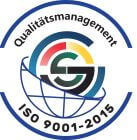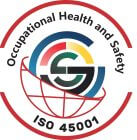Wenn sich der potentielle Kunde für die Beantragung einer ISO-Zertifizierung interessiert, setzt er sich mit GERMANCERT in Verbindung, telefonisch oder per Mail. Es kommt dann zu Gesprächen und dem Austausch von Informationen über das Unternehmen, wonach GERMANCERT dem Kunden ein Angebot unterbreitet, in dem Dauer und Zeitplanung des vorgeschlagenen Audits mitgeteilt werden. Wenn der Kunde mit dem Angebot einverstanden ist, kommt es zu einem Vertrag mit GERMANCERT.
Falls der Kunde es so wünscht, wird eine erste Untersuchung des Unternehmens durchgeführt, ein sogenanntes Vor-Audit oder vorläufiges Audit. Nach diesem freiwilligen Vor-Audit folgt der von dem Regelwerk vorgegebene Ablauf.
Es wird meistens vor Ort (weit gelegene Standorte müssen nicht vor Ort überprüft werden) eine Systemanalyse durchgeführt, in der die Systemdokumentation des Unternehmens geprüft und bewertet wird und aus einer ersten Einschätzung der Ziele und Ergebnisse der Managementbewertung und der internen Audits. Dabei werden die Feststellungen vom Auditor erklärt und die Zeitplanung bestätigt oder geändert. Dem Kunden wird vor der Durchführung der 2. Stufe des Audits eine ausreichende Frist gesetzt, um die eventuell festgestellten Schwächen zu beheben.
Der nächste Schritt, Audit Stufe 2, erfolgt nach positiver Bewertung der eventuellen Beseitigung von Schwachstellen, die in Audit Stufe 1 mitgeteilt worden waren. Der Abstand zwischen Audit Stufe 1 und Stufe 2 beträgt in der Regel drei Monate und darf nicht länger als sechs Monate betragen. Audit Stufe 2 hat den Zweck, die Umsetzung und die Wirksamkeit des Managementsystems des Kunden zu bewerten und muss an dem/den Standort(en) des Kunden stattfinden.
Das Auditoren-Team, der Fachliche Prüfer und die Geschäftsführung führen eine Bewertung der Ergebnisse des Audits durch und besprechen, ob einer Zertifizierung zugestimmt werden kann und erstellen Abweichungsberichte (falls nötig) mit Fristen zur Behebung der vorgefundenen Mängel.
Sind alle Mängel behoben und Verbesserungen zufriedenstellend von dem Kunden durchgeführt worden, erteilt der Fachliche Prüfer die Zustimmung zur Zertifikatserteilung.
Das erteilte Zertifikat hat eine Gültigkeit von drei Jahren.
Überwachungsaudits werden vor Ort durchgeführt, sind aber nicht notwendigerweise vollständige Systemaudits. Sie müssen jedoch mit den anderen Überwachungstätigkeiten geplant werden, damit GERMANCERT darauf vertrauen kann, dass das zertifizierte Managementsystem zwischen den Re- Zertifizierungsaudits nach wie vor die Anforderungen erfüllt. Das Überwachungsaudit muss mindestens folgende Punkte einschließen: interne Audits und Managementbewertung; Auditierung der wesentlichen Prozesse; eine Bewertung der ergriffenen Maßnahmen zu Nichtkonformitäten, die während des vorhergehenden Audits festgestellt wurden; Behandlung von Beschwerden; Effektivität des Managementsystems mit Blick auf das Erreichen der Ziele des zertifizierten Kunden; Fortschritte bei geplanten Tätigkeiten, die auf eine ständige Verbesserung zielen; anhaltende Betriebssteuerung/-lenkung; Bewertung von Änderungen, etc.
Überwachungsaudits müssen mindestens einmal im Jahr durchgeführt werden. Das Datum des ersten Überwachungsaudits, das der Erstzertifizierung folgt, darf nicht mehr als 12 Monate nach dem letzten Tag des Audits Stufe 2 liegen. Das Überwachungsaudit darf alle sechs Monate durchgeführt werden, darüber entscheidet der Kunde.
In der Regel findet der zweite Überwachungsaudit zwölf Monate nach dem ersten Überwachungsaudit statt. Es umfasst die Prüfung der wesentlichen Prozesse gemäß Auditzyklusplan sowie aller ungeprüften Prozesse aus dem ersten Überwachungsaudit. Zusammen mit dem ersten Überwachungsaudit müssen nun alle Prozesse mindestens einmal in den zwei Jahren begutachtet worden sein.
Das Re-Zertifizierungsaudit wird im Laufe des dritten Jahres der Gültigkeitsdauer des Erstzertifikates geplant und umgesetzt, um die Konformität und Wirksamkeit bezüglich aller Vorgaben der maßgeblichen Managementsystemnorm oder anderen normativen Dokumenten und des ganzen Managementsystems zu beurteilen und die anhaltende Anwendbarkeit auf den Geltungsbereich der Zertifizierung zu bestätigen. Das Re-Zertifizierungsaudit muss zwingend so geplant und durchgeführt werden, dass es vor Ablauf des noch gültigen Zertifikats abgeschlossen ist, inklusive der Beseitigung aller Abweichungen und der Zertifikatsentscheidung.
GERMANCERT kann eine Zertifizierung verweigern, wenn die Umstände des Auftraggebers sich so verändern, dass die Einhaltung der Normen des zertifizierten Regelwerkes nicht mehr möglich ist, oder der Kunde seiner Informationspflicht über diese Veränderungen gegenüber GERMANCERT nicht nachkommt, oder wenn die Korrekturmaßnahmen nicht so umgesetzt werden, dass die Mängel behoben werden können. In solchen Fällen kein ein Audit aus besonderem Anlass durchgeführt werden.
Dies beinhaltet die Entscheidung über die Aufrechterhaltung eines bestehenden Zertifikates. Verantwortlich für eine akkreditierungssichere Entscheidung ist eine kompetente Person oder ein berufener Fachlicher Prüfer oder ein FP-Experte mit einem berufenen Fachlichen Prüfer/kompetente Person zusammen.
GERMANCERT muss die Zertifizierung aufgrund der Darlegung, dass der Kunde weiterhin die Anforderungen der Norm des Managementsystems erfüllt, aufrechterhalten. GERMANCERT darf die Zertifizierung eines Kunden auf der Grundlage einer positiven Schlussfolgerung des Auditteamleiters ohne weitere unabhängige Bewertung und Entscheidung unter den folgenden Voraussetzungen aufrechterhalten:
GERMANCERT hat eine Politik und dokumentierte Verfahren zur Aussetzung, zur Zurückziehung oder zur Einschränkung des Geltungsbereichs der Zertifizierung und legt die zu ergreifenden Maßnahmen fest.
GERMANCERT setzt die Zertifizierung aus, wenn:
Bei Aussetzung ist die Managementsystem-Zertifizierung des Kunden zeitweise außer Kraftgesetzt.
GERMANCERT muss die ausgesetzte Zertifizierung wiederherstellen, wenn das Problem, das zur Aussetzung geführt hat, gelöst worden ist. Wenn die Probleme, die zur Aussetzung geführt haben, in einem von GERMANCERT vorgegebenen Zeitraum nicht gelöst worden sind, muss das zur Zurückziehung oder Einschränkung des Geltungsbereichs der Zertifizierung führen.
GERMANCERT muss den Geltungsbereich der Zertifizierung einschränken, um diejenigen Teile auszuschließen, die die Anforderungen nicht erfüllen, wenn der zertifizierte Kunde es dauerhaft oder schwerwiegend versäumt hat, die Zertifizierungsanforderungen für diese Teile des Geltungsbereichs der Zertifizierung zu erfüllen. Eine solche Einschränkung muss in Übereinstimmung mit den Anforderungen der für die Zertifizierung verwendete Norm erfolgen.



















In nur wenigen Schritten zu Ihrer Zertifizierung. Wir begleiten Sie von der ersten Analyse bis zum erfolgreichen Abschluss.
Wir analysieren Ihre aktuellen Prozesse und ermitteln den Bedarf für die Zertifizierung. Dabei klären wir, welche Normen relevant sind und welche Schritte notwendig sind.
Unsere erfahrenen Auditoren führen eine erste Prüfung durch und identifizieren Verbesserungspotenziale. Sie erhalten einen klaren Maßnahmenplan für die erfolgreiche Zertifizierung.
Wir begleiten Sie bei der Umsetzung der notwendigen Anpassungen, um alle Anforderungen der Normen zu erfüllen. Falls nötig, unterstützen wir Sie bei der Implementierung von neuen Prozessen.
Nach einer abschließenden Prüfung erhalten Sie Ihre offizielle Zertifizierung – ein Zeichen für Qualität, Nachhaltigkeit und Sicherheit in Ihrem Unternehmen.






GERMANCERT – Erfolg durch Zertifizierung
Eine Marke der GERMANCONSTRUCT GmbH – gegründet als Antwort auf die steigende weltweite Nachfrage nach ISO-Zertifizierungen, insbesondere von deutschen Zertifizierungsstellen. Wir unterstützen Unternehmen und Organisationen dabei, internationale Standards zu erfüllen und ihre Wettbewerbsfähigkeit zu stärken.